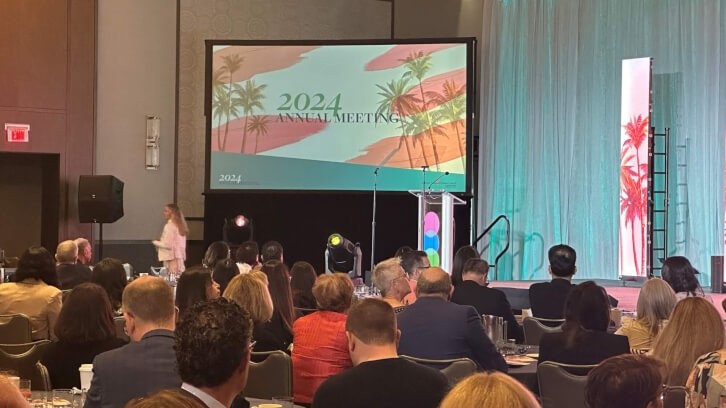CosmeticsDesign’s key takeaways from the 2024 PCPC Annual Meeting

For the first time since 2020, the Personal Care Products Council (PCPC) has held its Annual Meeting. The three-day conference featured speakers like Pulitzer Prize-winning journalist Evan Osnos and presentations spanning a broad array of topics across the personal care industry, including a forecast of the global market conditions, how to navigate the relationship between artificial intelligence (AI) learning language models (LLM) like Chat GPT and e-commerce, a timeline of the upcoming UN Plastic Pollution Treaty, and more.
Here is a look into our key takeaways from this year’s meeting.
The role of AI and social media in managing (and spreading) misinformation
In his opening remarks, PCPC President Thomas Myers asserted that “misinformation and its viral effects represent the most daunting challenge to our industry, which is why it’s imperative that we advocate for evidence-based public policies,” and that “safety decisions must be grounded in science.” This sentiment was echoed throughout the conference, focusing on the role of AI and social media in disseminating ingredient formulation research and development and the role this information plays in consumer purchasing behavior.
The conference’s keynote address, “How Conversational AI Will Change E-Commerce Forever,” speaker Max Bennett, Founder and CEO of AI company Alby, outlined the R&D behind functional LLMs, including the issues with the current stage of their technological advancement – the key takeaways being that while exceptionally useful when applied and used correctly, they will still get things wrong, and it is difficult to “teach” them new information or responses, and solutions to these issues are still being developed and implemented.
When applying conversational AI to e-commerce, specifically for the beauty and personal care product industries, there are currently two main types of use cases: internal-facing, like generating product copy, and external or consumer-facing, like shopping assistants or generating copy for reviews and FAQ sections.
Upon examining consumer-facing uses for LLMs, the key takeaway is that for e-commerce, one of the most successful applications is to help lead consumers on an ‘informational journey’ rather than a simple chatbot. By using the LLM to produce a generative Q&A where the AI predicts the consumer's questions before they are asked and to guide the consumer’s purchasing journey, there are much higher rates of successful conversion to purchase a product.
When looking to the future of AI in e-commerce, Bennett concluded that one of the more exciting innovations is multimodality, wherein LLMs can look at pictures in addition to text and incorporate them into response generation. Future innovations also include AI-powered robotics, which, while still a few years out, can potentially revolutionize the product manufacturing industry.
The underlying theme in this and the following discussions is trust and how industry members can build and maintain that trust within the consumer relationship. In the discussion on “Exploring the Complexities of the New Value Chain,” Elisabeth Anderson, Director of Science Communication, Center for Research on Ingredient Safety, Michigan State University, and Michael J. Fevola, Ph.D. Vice President, R&D and Product Stewardship at Inolex, the speakers examined the evolution of the traditional supply chain into today’s model, which highly emphasizes the demand for information and interdependency between the chain’s ‘links.’ The sharing of knowledge, explained Dr. Fevola, is crucial to the success of the value chain as it signals trust and trust is signaled by understanding and knowing intent, ability, character, and track record.
Social media is the vehicle for establishing and maintaining trust in the parasocial relationship between consumer and company, the discussion continued, with the key to the vehicle being accessible content or transparency in information. As consumers continue to have greater access to information and are increasingly more informed than ever, organizations like the Center for Research on Ingredient Safety use social media to combat the prevalence of misinformation that damages trust in the value chain.
The impact of global policies and intra-continental relationships
The role of global policies and the relationships between companies and consumers in countries like the US and China were another significant area of focus throughout the conference. In the fireside chat between Francine Lamoriello, EVP of Global Strategies at PCPC, and Evan Osnos, Staff Writer at The New Yorker, CNN contributor, and Senior Fellow at the Brookings Institution, one of the key takeaways is that companies in the personal care space with a global presence are currently having to navigate ‘the end of the era of engagement,’ as China, like many countries following the downturn of the COVID-19 pandemic, is recently coming out of a period of unstable growth.
One of the most significant changes happening in the minds of the Chinese consumer is the trend of wanting to ‘lie flat,’ explained Osnos, which Lamoriello likened to ‘quiet quitting,’ or the phenomena embracing a life ideology focused on minimalism, simplicity, and connection to the present moment. While “it is possible to have ambitions in the Chinese market and find the targeted consumer,” Osnos noted, the implications of it being an election year in the US and the changes in consumer mindset in both countries are worth considering for industry companies.
On a more global scale, a breakout session on the UN Plastics Pollution Treaty, which is currently underway, provided a different perspective on the impact of international policy and evolving global relationships on the market. The resolution is based on three initial draft proposals by representatives from Japan, Peru, and Rwanda, aiming to create an internationally binding agreement to ultimately move the global need for plastics “from pollution to solution.”
The established intergovernmental negotiation committee (INC) has been tasked with presenting a legally binding resolution to be adopted in 2025 to develop diverse alternatives throughout the lifecycle of plastics and include nanoplastics in the cosmetics industry. Five INC sessions are scheduled to occur, with the fourth and next session planned for Ottawa, Canada, next month.
With a variety of stakeholders having vested interest in the outcome of this action, speaker Melissa Kopolow, Associate Partner, Albright Stonebridge Group, urged industry members to engage with trade associations like the PCPC to voice their support for or concerns regarding the treaty to have those interested adequately represented throughout the negotiation process.
The evolving role of communication in sustainability
A final pervasive point of discussion during the conference was the evolving role of effective communication between company and consumer, particularly in sustainability. While sustainability has become a mainstay in many companies' marketing and product formulation processes, more than maintaining a stance of sustainable and ethical practices is needed for consumers. As speaker Michael Maslansky, CEO of Maslanksy + Partners, shared in his discussion on “Building Trust in an Era of Polarization,” it’s “not what you say, it’s what you hear,” meaning that it’s not just language, but actions requiring authenticity to be effective in communication.
Building on this concept, speakers Carol Cone, CEO and Founder, Carol Cone ON PURPOSE, and Harold Hamana, Managing Partner, Knight & Pawn, in a discussion moderated by Lisa Powers, EVP, Public Affairs & Communications at PCPC, explored the different ways companies are reinventing how they communicate environmental and ethical responsibility into action.
Cone and Hamana explained the types of language shifts they are currently seeing, which include a movement towards education and wellness in messaging, with more extraordinary efforts towards basing communication in more globally broad research that can be translated to be more relatable to consumers in local markets.
The speakers also stressed the importance of testing messages in emerging markets and building brand-focused communities, creating a natural testing group for future messaging campaigns. For example, some companies are creating umbrella names for their initiatives, which creates entropy in the connection between business and local culture to encourage the formation of targeted communities.
As the need for sustainability messaging has become universal, the speakers concluded, themes like climate change, education, and wellness will continue to make it easier for brands to connect in different markets by fostering different levels of development or need through layers of shared understanding.
















